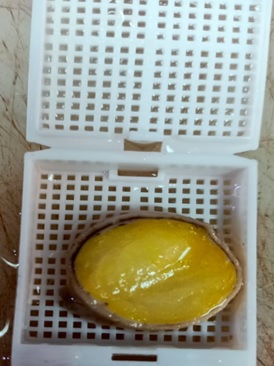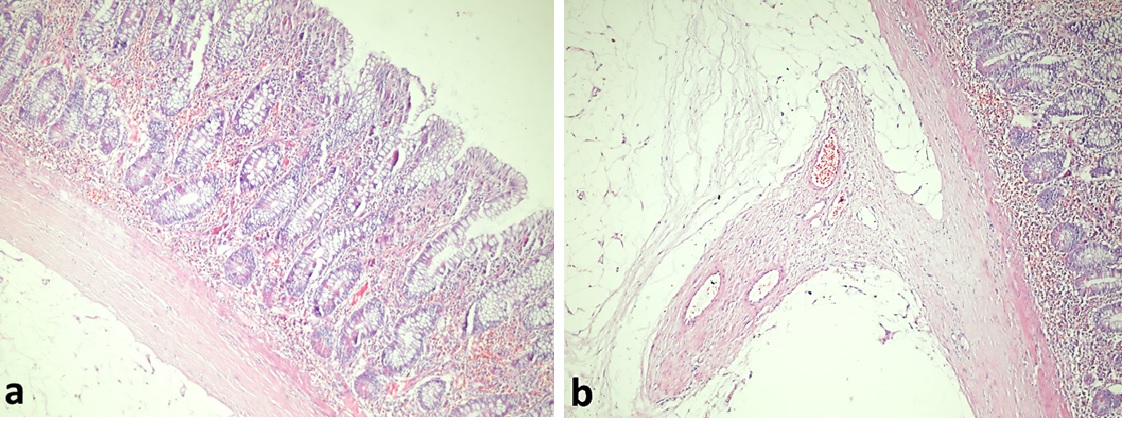A Submucosal Lipoma of Small Intestine as an Unpredictable Cause of Intussusception and Intestinal Obstruction; A Case Report and Literature Review
Download
Abstract
Background: Intussusception refers to telescoping of one intestinal segment and its mesentery into an adjacent intestinal loop. It is a rather frequent entity in infants with an excellent prognosis. However, intussusception in adults is a rare surgical problem which almost always results from a pathological cause which interferes with intestinal motility.
Methods: A 71-year-old woman suffered from severe colicky abdominal pain, nusea and vomiting. Clinical examination and radiological findings highly suspected a case of intussusception. Exploratory laparotomy and relief of intussusception were achieved. There was a soft intraluminal small intestinal mass. Resection anastomosis of the small intestinal loop which harbored the polyp was done. The specimen was subjected to pathological evaluation.
Results: The pathological evaluation revealed a submucosal lipoma of the small intestine, protruded in the intestinal lumen as a pedunculated polyp with intact overlying mucosa.
Conclusion: Lipoma of the small intestine should be suspected in any case of intussusception, especially in adults.
Introduction
Intussusception implies that an intestinal segment and its mesentery are incorporated within the lumen of the nearby intestinal loop. The former is called an intussusceptum, while the latter is called an intussusceptien. Most cases of Intussusception occur in the first decade of life, especially the first year, in which more than 50% of the reported cases of Intussusception occur. Causes of Intussusception vary according to the age; in pediatric age group, the most frequent cause of Intussusception is lymphoid hyperplasia in the ileo-cecal region [1], while in older children and adults, the cause of Intussusception is usually as a result of a pedunculated intraluminal small intestinal tumor as carcinoma, lymphoma, gastro-intestinal stromal tumor (GIST), or rarely lipoma [2, 3].
Lipoma is a benign mesenchymal tumor formed of benign lipocytes. Lipoma virtually occur in any site of the body [4]. Gastrointestinal lipoma is a rare entity. Most cases of Gastrointestinal lipoma occur in large intestine, followed by small intestine [5]. Small sized Gastrointestinal lipomas are usually asymptomatic, while those which are ≥ 2cm in diameter usually present clinically by Gastrointestinal bleeding, iron-deficiency anaemia, intussusception or bowel obstruction [6]. Herein, we reported a 71-year-old lady who was admitted to the Surgery Department, Sohag University Hospital as she suffered from severe, diffuse colicky abdominal pain and vomiting. Clinical examination and sonography highly suspected a case of intussusception. Exploratory laparotomy was done and relief of intussusception was performed. There was a soft intraluminal small intestinal polyp. Resection anastomosis of the small intestinal loop which harbored the polyp was done. The specimen was sent to the Pathology Department to detect the nature of that polyp.
Case presentation
Patient information and Clinical findings
A 71-year-old woman admitted to Surgery Department, Sohag University Hospital because of sever colicky abdominal pain, nusea and vomiting. The patient mentioned that she was suffering from intermittent colicky abdominal pain and constipation in the last three weeks.
Physical examination revealed a tender mass in the right lower quadrant of the abdomen. Abdominal ultrasound revealed pseudokidney sign. From previous clinical and radiological findings, intussusception was suspected.
The patient underwent exploratory laparotomy.
There was an ileo-colic intussusception. Relief of the intussusception was achieved by gentle milking of the intussusceptum from distal to proximal direction. After reduction, there was an intraluminal soft mass, located about 20 cm proximal to ileo-cecal junction. Resection anastomosis of the involved segment of the small intestine was performed. The specimen was sent to Pathology Laboratory, Sohag University, for histopathological evaluation. The patient recovered and she was discharged 6 days after the operation.
Pathological features
The specimen was opened longitudinally, it revealed a pedunculated polyp with intact overlying mucosa. The polyp was 4.5x 2cm. cut section of the polyp was solid, homogenous yellow and greasy (Figure 1).
Figure 1. Cut section of the resected small intestinal polyp.

Microscopic examination of the polyp revealed small intestinal mucosa and sub mucosa. The mucosa is formed of villi and crypts lined by a single layer of tall columnar and goblet cells. the lamina propria is edematous and showed marked congested blood vessels. The submucosa showed a capsulated mass formed of mature lipocytes, arranged in lobules which are separated by fibrous septa (Figure 2).
Figure 2. Microscopic appearance of submucosal lipoma; the submucosa is occupied by a capsulated neogrowth formed of mature lipocytes (a; x 40), the capsule sends fibrous septa which harbors blood vessels (b; x 100).

The diagnosis of small intestinal submucosal lipoma was assigned.
Discussion
Intussusception is a common surgical problem in infants, especially in the first year of life. However, it is an uncommon entity in adults. Intussusception can be categorized into idiopathic and secondary categories. Idiopathic Intussusception represents the most frequently occurring cases of intussusception in infants and it carries an excellent prognosis. Secondary intussusception, which is more common in adults than in infants, is caused by a pathological factor which interferes with intestinal movement as Meckel’s diverticulum, polyps or tumors [5]. Lipoma is a benign mesenchymal tumor formed of benign lipocytes. It represents 2-3% of all non-malignant tumors occur in the gastrointestinal tract. Most cases of gastrointestinal lipomas occur in the large intestine, especially in the cecum and ascending colon. Small intestinal lipomas represent one fifth to one fourth of all cases of gastrointestinal lipomas. Most cases of small intestinal lipomas were reported in fifth to seventh decades of life and most of these cases were reported in women [7,8]. Unlike the large intestinal lipomas, those located in the small intestine are usually symptomatic, especially if they are larger than 2 cm [9], this can be attributed to the free motility of the small intestine compared to the large intestine. According to their location within the layers of the gastrointestinal system, gastrointestinal lipomas can be divided to three categories; submucosal, intermuscular and subserosal lipomas. Submucosal lipomas represent about 90% of the reported cases. They elevate the mucosa and appear as a polypoid mass. The optimal treatment of small intestinal lipoma is resection of the tumor by partial small bowel resection. The resected bowel lipomas don’t recur. No previous literatures mentioned malignant transformation of gastrointestinal lipomas [5]. .
We reported a 71-year-old woman presented with severe colicky abdominal pain. Clinical and radiological findings confirmed a case of intussusception. According to the patient’s age, the possibility of small intestinal tumor was highly suggested. After relief of the intussusception, careful examination of the intussuscepted small intestinal loop revealed an intraluminal polyp. Resection anastomosis of the small intestinal loop which entangled the polyp was done. Pathological examination of the polyp showed that this poly was covered by an intact mucosa, this finding raised the possibility of the benign nature of this polyp. Cut section of the polyp revealed benign features as it was circumscribed, solid and homogenous. The yellow color of the polyp in addition to the greasy sensation suggested lipoma which was confirmed histologically.
In conclusion, despite being an infrequent entity, small intestinal lipoma should be suspected in any case of secondary intussusception, especially in adults.
Competing interests
The author declares that she has no competing interests.
Funding
No financial support was received for this study.
References
- Intestinal intussusception associated with adenovirus infection in Mexican children Guarner Jeannette, Leon-Bojorge Beatriz, Lopez-Corella Eduardo, Ferebee-Harris Tara, Gooding Linda, Garnett C. T., Shieh Wun-Ju, Dawson Jacqueline, Erdman Dean, Zaki Sherif R.. American Journal of Clinical Pathology.2003;120(6). CrossRef
- Lipoma of the Small Intestine: A Cause for Intussusception in Adults Vagholkar Ketan, Chavan Rahulkumar, Mahadik Abhishek, Maurya Inder. Case Reports in Surgery.2015;2015. CrossRef
- Adult intussusception: a retrospective review Honjo Hirotaka, Mike Makio, Kusanagi Hiroshi, Kano Nobuyasu. World Journal of Surgery.2015;39(1). CrossRef
- Complete small bowel obstruction without intussusception due to a submucosal lipoma Konik Ryan D., Rhodes Ronald A.. Journal of Surgical Case Reports.2018;2018(7). CrossRef
- Small intestinal submucosal lipoma: a rare cause of secondary intussusception in a child Cheikhrouhou Taycir, Dhaw Mahdi Ben, Zouari Mohamed, Zitouni Hayet, Kallel Rim, Gouiaa Naourez, Boudawara Tahya Sellami, Mhiri Riadh. Annals of Pediatric Surgery.2021;17(1). CrossRef
- Laparoscopic Resection of a Small Bowel Lipoma with Incidental Intussusception Lucas Layla C., Fass Ronnie, Krouse Robert S.. JSLS : Journal of the Society of Laparoendoscopic Surgeons.2010;14(4). CrossRef
- Small intestinal lipomas: Diagnostic value of multi-slice CT enterography Fang Song-Hua, Dong Dan-Jun, Chen Fang-Hong, Jin Mei, Zhong Bai-Shu. World Journal of Gastroenterology.2010;16(21). CrossRef
- Lipoma induced jejunojejunal intussusception Manouras Andreas, Lagoudianakis Emmanuel E, Dardamanis Dimitrios, Tsekouras Dimitrios K, Markogiannakis Haridimos, Genetzakis Michael, Pararas Nikolaos, Papadima Artemisia, Triantafillou Christos, Katergiannakis Vagelogiannis. World Journal of Gastroenterology : WJG.2007;13(26). CrossRef
- Symptomatic lipomas of the gastrointestinal tract Ackerman N. B., Chughtai S. Q.. Surgery, Gynecology & Obstetrics.1975;141(4).
License

This work is licensed under a Creative Commons Attribution-NonCommercial 4.0 International License.
Copyright
© Asian Pacific Journal of Cancer Biology , 2022
Author Details